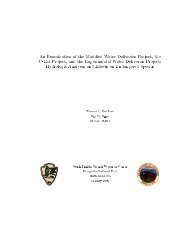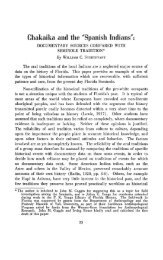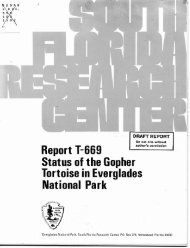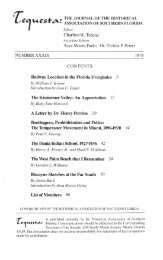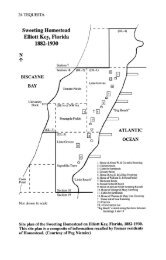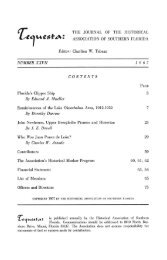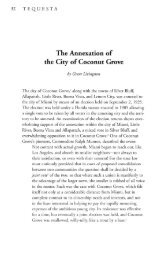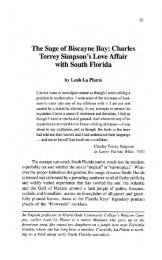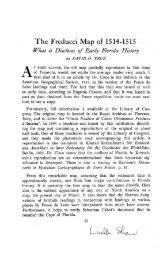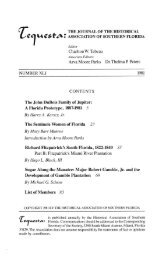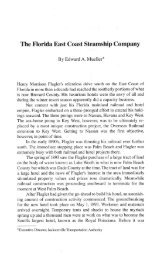Miami During the Civil War - FIU Digital Collections
Miami During the Civil War - FIU Digital Collections
Miami During the Civil War - FIU Digital Collections
You also want an ePaper? Increase the reach of your titles
YUMPU automatically turns print PDFs into web optimized ePapers that Google loves.
<strong>Miami</strong> <strong>During</strong> <strong>the</strong> <strong>Civil</strong> <strong>War</strong> 39<br />
mailman for <strong>Miami</strong>, and had many narrow escapes from <strong>the</strong> Indians.<br />
2 1<br />
The home of Theodore Bissell was far<strong>the</strong>r west on <strong>the</strong> south<br />
fork of <strong>the</strong> <strong>Miami</strong> River. He served in Tallahassee as a state representative<br />
from Dade County in 1858, '59, and '60. His fellow pioneers<br />
looked forward to his return to <strong>Miami</strong> because he brought news of <strong>the</strong><br />
outside world and stories of <strong>the</strong> impending war. 22<br />
Michael Axer, or Oxar, lived across <strong>the</strong> river, east of <strong>the</strong> Bissell<br />
home. Aged 35 in 1860 and nicknamed "Dutch Mike," he was from<br />
Darmstadt, Germany. His homesite was on a spring at Wagner Creek. 23<br />
On <strong>the</strong> bay about three miles north of <strong>the</strong> river lived Michael Sears,<br />
or "French Mike," who was 50 years old in 1860. From Alsace-<br />
Lorraine, his name is "Chairs" in <strong>the</strong> 1860 Census and sometimes<br />
appears in <strong>the</strong> records as "Zairs." Arriving in 1858 with his son<br />
George, 15, and his daughter Caroline, 5, Sears cleared bayfront<br />
land, built a house with a loft, and constructed a dock. Later he also<br />
built a starch mill, raised a few hogs that ran wild, and planted fruit<br />
trees. These included coconut trees that made his home a distinctive<br />
landmark for mariners. A trader when he could get anything to sell,<br />
Sears cruised <strong>the</strong> coast in his sloop searching for wrecks or cargo<br />
washed up on <strong>the</strong> beach. At times <strong>the</strong> entire family went on scavenger<br />
hunts along <strong>the</strong> beach, but usually Sears left his daughter alone when<br />
he and his son went wrecking or sailed on frequent trading trips to<br />
Key West. When <strong>the</strong> <strong>Civil</strong> <strong>War</strong> threatened, Sears arranged for a<br />
family in Key West to take care of his lonely little girl, and his son<br />
went north to a small community on Indian River.<br />
French Mike had a close neighbor, Dan Clarke, who was single<br />
and without a family. A former sailor, Clarke raised pigs and horses.<br />
In 1877 his housekeeper was a black woman, Lizzie Holland. She<br />
may have been his slave before <strong>the</strong> war. No one else lived on upper<br />
Biscayne Bay. 2 4<br />
The o<strong>the</strong>r settlers living in <strong>the</strong> vicinity when <strong>the</strong> <strong>Civil</strong> <strong>War</strong><br />
began included Isaiah Hall and Simeon Frow. Hall, who had several<br />
residences, arrived in 1858 with a wife and six children. His homestead<br />
was on <strong>the</strong> coast just south of what is now Ma<strong>the</strong>son Hammock<br />
Park. Frow, head lighthouse keeper at <strong>the</strong> Cape Florida Light since<br />
<strong>the</strong> year of his arrival, lived on Key Biscayne next to <strong>the</strong> lighthouse.<br />
He was born on <strong>the</strong> Spanish Island of Minorca of an English fa<strong>the</strong>r<br />
and a Minorcan mo<strong>the</strong>r.



